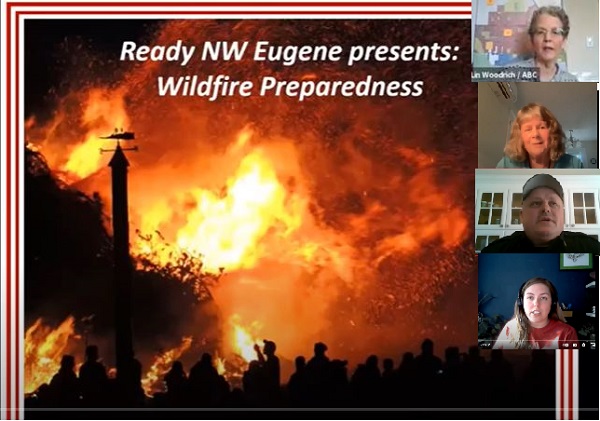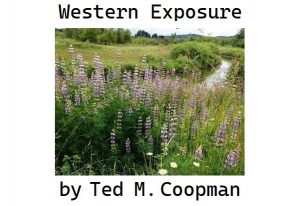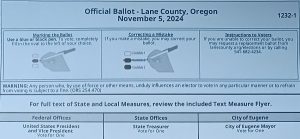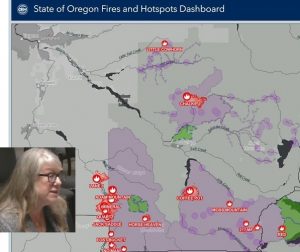Ready NW tips for wildfire preparedness: Meet your neighbors
7 min read
Volunteers from three Northwest Eugene neighborhoods offer tips on preparing for fire season. From Bethel, Ready NW volunteer Lin Woodrich.
[00:00:08] Lin Woodrich: It’s important to create the defensible space around your home: Eliminate all combustible materials within 30 feet of the home and, place woodpiles at least 30 feet from the building and store the wood in a vegetation-free zone, such as a graveled area. Prune and remove dead and dying branches from individual and well-spaced clumps of trees and shrubs. So in other words, just make it as clean as you can and keep everything that you can away from the house.
[00:00:34] They say there are no fireproof plants, but some are more fire resistant. Less flammable and likely to ignite in a wildfire are: low-growing or a small species, easy to maintain and prune; have an open, loose branching pattern; burn less intensely when ignited and spread the fire slower.
[00:00:54] John Q: Lin encouraged neighbors to identify where burning embers might ignite.
[00:00:58] Lin Woodrich: To reduce the risk of wildfire in residential areas, cleaning and fixing places on houses where burning embers could fall and start fires;
[00:01:06] Clearing flammable materials that are next to houses; preventing ground fires from climbing up into shrubs and trees; spacing shrubs and trees so fire can’t travel, replacing flammable decks, fencing, and siding; clean roof gutters; change vent screens from one quarter inch to one eight inch. The vent screens are the screens that allow air to flow, like, underneath your house and in the attic areas and in the screen size. If you have a quarter-inch screen, it allows the embers to get in much easier than having a smaller screen size.
[00:01:43] John Q: Lin also encouraged neighbors to learn their evacuation zones.
[00:01:47] Lin Woodrich: When we had the horrible fires and it was all, it looked like Armageddon here. And I had my go-bag on my bed. I was ready no matter what. But Level One Be Ready is, you want to pack your valuables and include important documents, such as passports, birth certificates, insurance information, medications, and medical equipment. Put your emergency supply kit in your vehicle, back your car, into the driveway with vehicle loaded, carry your car keys with you. Monitor the situation.
[00:02:17] Don’t wait for an evacuation order if you feel threatened. If it says level one, and you want to go right now, go, you don’t have to wait. Locate your pets and keep them nearby. Prepare large animals for transport and consider moving them to safe location early and check on neighbors and make sure they’re preparing to leave.
[00:02:36] For Level Two, there’s a significant danger to your area. You should either leave the area now or be prepared to leave at a moment’s notice level to be set. Don’t wait to be ordered by the authorities to leave. Evacuating the affected area early helps responders keep roads clear of congestion.
[00:02:55] You may not receive another notice. In a fast-moving emergency, it’s important that you do not hesitate to evacuate if you feel unsafe.
[00:03:04] Monitor the news. Follow Lane County Sheriff’s office and your local fire department, social media pages, as well as local television and radio news broadcasts.
[00:03:14] And then people who need help or more time to evacuate should evacuate at Level One or Level Two. This includes assisted living centers, people with disabilities, people needing help with small children, people with medical conditions and people with large animals.
[00:03:31] And then Level Three Go Now, leave immediately. Danger is current or imminent in your area. Evacuate. Information will be provided regarding where you can go to get information, resources and support, Do not stop to gather items or make efforts to protect your home. Follow the directions of law enforcement and emergency personnel.
[00:03:52] Take your pets with you.
[00:03:53] In Level Three, ‘Go Now’ is the last notice you’ll receive. If you choose to ignore the evacuation notice, emergency personnel may not be able to assist you later. Once you leave, do not return to your home until officials determine it’s safe. Notification that it is safe to return home will be given as soon as possible, considering safety and accessibility.
[00:04:15] John Q: Lin encouraged neighbors to become familiar with their evacuation zone numbers. Those numbers are used during emergencies.
[00:04:22] Lin Woodrich: We have five zones in Bethel, this large area. And I live in 15 and because it’s such a large area we have five zones. We’ve decided to do zone park events so people can learn what zone they’re in. And so we’ve designated a park for each zone. And we’re going to be doing events all summer long in our books. So that’s that’s the Bethel zones, 9, 10, 11, 15, and 16.
[00:04:46] The Santa Clara zones are 13 and 20. And then River Road are zones 14 and 22.
[00:04:52] So who’s going to save you? Who can you rely on to help you after a disaster who will provide you with food, water, shelter, and medical care? You might be surprised by the answer: You and your neighbors.
[00:05:02] During an emergency or natural disaster, first responders may not be able to assist our neighborhoods right away. You and your neighbors may become your own first responders.
[00:05:12] We have some programs that our neighborhood organizations can help you with. One of them is Map Your Neighborhood, and you can do this for your own neighborhood just on your own if you want to put together—what I did was I did a Neighborhood Watch and we just walked the neighbors and got all their information so that we could have a phone list and people could alert each other if there was a problem. And then we also could help each other if we had elderly people on the street.
[00:05:37] But you can go through and list skills that the different neighbors have— if you have a nurse on your street or carpenters, or somebody has a chainsaw that could cut down some wood if it fell across the street, and talk to your neighbors, just get to know your neighbors, is pretty much the key here. And working together as a team to evaluate your neighborhood.
[00:05:58] John Q: Megan Kemple can help you organize your nearby neighbor groups.
[00:06:02] Megan Kemple: This is Megan from the Whiteaker. And I could just share that I have been supporting people, training people to do the Map Your Neighborhood. And I’ve done that several times with my neighbors. And so if anybody would like more information about how to do that, I’m happy to help you.
[00:06:19] John Q: From River Road, Charlsey Cartwright.
[00:06:21] Charlsey Cartwright: I have started with my neighbors on Norman Avenue. And I heard of another one a couple of blocks over, a group that meets periodically around an outdoor fire pit. They just get together in the evening and talk and that’s how they do it. I think it’s so nice if people can be kind of organic and allow the personality of their area to of dictate that they want to do that. It really is about meeting each other and just having a conversation regularly about how they can improve their preparedness.
[00:06:57] Lin Woodrich: And I forgot to mention, I just got trained as a CERT.
[00:06:59] You learn disaster fire suppression, basic first aid and bleeding control, light search and rescue, and disaster psychology and team organization. So, um, I know how to do all kinds of interesting things. Boy, was it ever a good training. Ed (Ferren) was there and yeah, we went into a building and had to find people and learned how to use a fire extinguisher. It was really cool.
[00:07:23] So CERTs are basically the first responders until the actual first responders arrive. It’s important to have CERTs all through the neighborhoods so that, that way they can help organize the teams of people to keep us safe.
[00:07:42] Deputy Merrill Harrison: I’ve got to say, Lin, I should never follow you when you give a presentation. Kudos for that, that’s an absolutely wonderful presentation and a job well done. What I hope to do is just to kind of reiterate and enforce some of the things that Lin talked about.
[00:07:55] Really the key to defensible space or emergency preparedness, is you have to remember that it really starts at your front door, right. It starts at your home and then extends out much like the defensible space zones. And it includes your entire neighborhood.
[00:08:08] Reaching out to your neighbors and getting to know your neighborhood—years and years ago, that was a common occurrence. And it seems like it’s unfortunately gotten less likely to occur, but in emergency preparedness and in any type of planning for a neighborhood, it’s amazing the benefits that you’ll get from getting to know your neighborhood.
[00:08:27] Working on defensible space projects as a group, as a team, you can accomplish so much more than if you were doing it by yourself.
[00:08:36] There’s been multiple neighborhoods that I’ve dealt with that literally will go home to home and they’ll work together as a group to create defensible space for people within their neighborhood. And you also, you learn to identify people who may need additional help, right?
[00:08:50] The snowstorm we had, was it a couple years ago? There were neighborhoods who had banded together and removed snow and removed debris. And it was amazing to see the benefits that came out of simply knowing your neighbor. So, getting to know your neighbors is highly recommended, and working together as a group for your common goal really benefits the entire neighborhood as a whole.
[00:09:13] John Q: Deputy Merrill Harrison and Ready NW recommend one way to prepare. Enjoy some time with neighbors.



